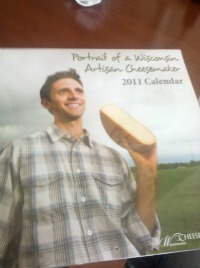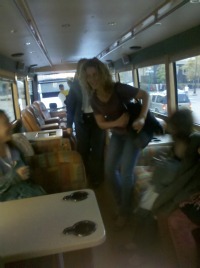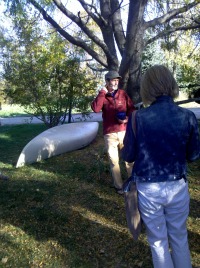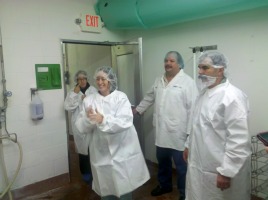| « Friday Foodporn: His Devilish Grin | Adieu May Street Market » |
Feature Fri Oct 29 2010
Cheese, Glorious Cheese
 The first thing I pulled out of the gift bag was a hanging calendar with a man on the cover holding half a wheel of golden cheese. I immediately took a photo and texted it to a friend: "The cheese journey begins."
The first thing I pulled out of the gift bag was a hanging calendar with a man on the cover holding half a wheel of golden cheese. I immediately took a photo and texted it to a friend: "The cheese journey begins."
I had no idea then that man was Andy Hatch, a cheesemaker at Uplands Cheese Company, and he was holding their award-winning Pleasant Ridge Reserve. (As pretty much everybody loves to point out, Pleasant Ridge has won the American Cheese Society's Best of Show award three times--no other cheese has won even twice).
But let's not jump too far ahead here. I was in Madison for a three-and-a-half day media trip sponsored by the Wisconsin Milk Marketing Board, a nonprofit funded by dairy farmers that promotes the wide variety of Wisconsin cow's-milk cheese. They work with other dairy products too -- milk, yogurt -- but 90 percent of the state's cow's milk is used to make (you guessed it) cheese.
 Over the course of the trip, a group of about 20 food journalists and bloggers from around the country visited seven different cheesemakers around the state, including Bleu Mont and Willi Lehner's famous aging cave, and Otter Creek Organic Farm, which makes seasonal cheeses that even Rick Bayless loves. Our ride: a plush, limo-bus that drove us from Madison to Spring Green and back.
Over the course of the trip, a group of about 20 food journalists and bloggers from around the country visited seven different cheesemakers around the state, including Bleu Mont and Willi Lehner's famous aging cave, and Otter Creek Organic Farm, which makes seasonal cheeses that even Rick Bayless loves. Our ride: a plush, limo-bus that drove us from Madison to Spring Green and back.
As you might imagine, Wisconsinites take their cheese very -- very -- seriously. Maybe it was the crowd I was with (a crowd that included many cheese specialty writers like former Wisconsinite Madame Fromage), and the pin-up calendar probably didn't hurt, but I felt like I was in the presence of celebrities around these cheese artisans. There was chatter about Andy Hatch and Gary Zimmer, owner of Otter Creek Organic Farm -- "oh, he won't be there," said one of my tour mates. "He's always away at speaking engagements" -- before we even got to their home ground. (We did actually get to meet Zimmer, a vivacious 65-year-old passionate about his farm's mission.) We'd also heard about Sid Cook (Mr. October) and Bob Wills, two of only about 50 Master Cheesemakers in the state, a designation awarded after completing a rigorous program at the University of Wisconsin-Madison's Center for Dairy Research.
Cheesemaking has a few basic steps, some of which we saw at each of the places that made their cheese on the premises -- some, like Bleu Mont, work with other cheesemakers that have the facilities and outsource the actual process:
- Start with the milk.
- Add the cultures, the mix of bacteria that start to turn the milk from liquid to solid.
- Add the rennet, enzymes that used to come from animal stomachs, but most cheesemakers now use plant-derived rennet--this will cause further coagulation of the milk.
- Use a rake-like implement to separate the curds from the whey, drain off the whey, and salt the curds to help preserve them naturally.
- Press the curds into a mold, which will also squeeze out any remaining whey.
- Age that baby.
But there are certain elements unique to each cheesemaker that produce the huge variety: the specific mix of cultures, for example, or the way a cheese is aged; whether coloring is added or whether the cheesemaker uses raw or pasteurized milk.
The raw-versus-pasteurized debate seemed to come up at every place we went. The laws when it comes to raw-milk cheese are fairly strict: it's illegal to sell raw-milk cheese unless it's been aged for 60 days or more (the aging process kills some of the bacteria). But the cheesemakers all have different opinions.
Cedar Grove's Master Cheesemaker Bob Wills knows that "60 days isn't sufficient to know all the pathogens are gone." About 60 percent of the milk he uses for his cheese is certified organic, which means that the farmers don't use chemical pesticides or any genetically modified microbial enzymes. But many of his customers who want organic do prefer raw-milk cheeses. Over time, though, says Wills, "salts, low moisture levels, and competing cultures will provide a safe product."
 Willi Lehner of Bleu Mont -- the "mountain man," as one of our Wisconsin Milk Marketing Board hosts called him -- believes that raw milk is the best way to go. Born to Swiss parents, when he was younger, he and his brother made cheese in a copper kettle over a wood stove. He realized early the connection between what cows eat and the final product. Now Lehner produces some raw-milk cheese (he doesn't have the resources to process the cheese on hand, so works with Wills at Cedar Grove to make it) and ages it in his underground cave, carved into rock on his property in Blue Mounds. "You don't notice the difference [with raw-milk cheese] until about eight months," he says. The enzymes and bacteria, killed during the pasteurization process, impart unique flavor and need time to "express themselves" -- "it's not something you can really force." He doesn't own any cows, so he buys his milk from local organic dairy farmers who practice rotational grazing.
Willi Lehner of Bleu Mont -- the "mountain man," as one of our Wisconsin Milk Marketing Board hosts called him -- believes that raw milk is the best way to go. Born to Swiss parents, when he was younger, he and his brother made cheese in a copper kettle over a wood stove. He realized early the connection between what cows eat and the final product. Now Lehner produces some raw-milk cheese (he doesn't have the resources to process the cheese on hand, so works with Wills at Cedar Grove to make it) and ages it in his underground cave, carved into rock on his property in Blue Mounds. "You don't notice the difference [with raw-milk cheese] until about eight months," he says. The enzymes and bacteria, killed during the pasteurization process, impart unique flavor and need time to "express themselves" -- "it's not something you can really force." He doesn't own any cows, so he buys his milk from local organic dairy farmers who practice rotational grazing.  Inside his cave, which filled my nose with the nutty, sweet, cold scent I know from my years working at a cheese counter in college, has two separate chambers. One is for drier cheeses, like his Bandaged Cheddar, wrapped in a muslin cloth that smells slightly like Band-Aids. The other is for the washed-rind cheeses such as his Alpine Renegade, a hard cheese that Lehner keeps wet by hand-smearing each wheel with a brine, to promote bacteria and yeast growth on the outside. (This produces its distinctive aroma -- aka, stink.) Both made with raw milk, these are two of his big sellers, which he sells primarily at Madison farmers' markets.
Inside his cave, which filled my nose with the nutty, sweet, cold scent I know from my years working at a cheese counter in college, has two separate chambers. One is for drier cheeses, like his Bandaged Cheddar, wrapped in a muslin cloth that smells slightly like Band-Aids. The other is for the washed-rind cheeses such as his Alpine Renegade, a hard cheese that Lehner keeps wet by hand-smearing each wheel with a brine, to promote bacteria and yeast growth on the outside. (This produces its distinctive aroma -- aka, stink.) Both made with raw milk, these are two of his big sellers, which he sells primarily at Madison farmers' markets.
Cheesemakers Andy Hatch and Mike Gingrich at Uplands also make raw-milk cheese, that triple-award-winning Pleasant Ridge Reserve. Pasteurizing the milk, said Gingrich, who turned over the cheesemaking responsibilities to Hatch in 2008, "all the things that factories do to turn out a consistent product, robs the milk of its unique character." Hatch agreed: "The more diverse set of bacteria," said Hatch, "the more complex of a flavor." The Pleasant Ridge used to be their only product, but Hatch is working hard on a new cheese, Rush Creek Reserve. "It's been a pain in the ass," he said. He's spent his nights experimenting for months with the soft, custardy cheese, trying to pace the ripening with the 60-day aging law. I'm not sure whether it was just the raw milk, though, that made me favor these smaller, more hands-on cheesemakers, compared to the larger, more factory-like places (some of which also used raw milk). We visited Uplands just before going to Emmi-Roth Käse, an ultra-sanitized cheesemaking plant. We had to take off all of our jewelry before going inside, put on a white coat, and covered our hair and shoes with plastic. The bearded men had to wear beard guards. And at the entrance to every room, there were alcohol- and chlorine-based foot baths to decimate whatever bacteria might be lurking on the bottoms of our plastic-covered shoes. The employees wash their hands about 200 times per day.
I'm not sure whether it was just the raw milk, though, that made me favor these smaller, more hands-on cheesemakers, compared to the larger, more factory-like places (some of which also used raw milk). We visited Uplands just before going to Emmi-Roth Käse, an ultra-sanitized cheesemaking plant. We had to take off all of our jewelry before going inside, put on a white coat, and covered our hair and shoes with plastic. The bearded men had to wear beard guards. And at the entrance to every room, there were alcohol- and chlorine-based foot baths to decimate whatever bacteria might be lurking on the bottoms of our plastic-covered shoes. The employees wash their hands about 200 times per day. Yes, we had to take our shoes off inside Lehner's cave, and at Uplands we also wore hair nets and shoe covers, but the hyperfocus on sanitization at Roth Käse stripped it of its charm (like the employees' hands are stripped of any moisture). While, at Bleu Mont, Willi smears and turns each wheel by hand, two robots, Sam and Heidi, take care of that.
Yes, we had to take our shoes off inside Lehner's cave, and at Uplands we also wore hair nets and shoe covers, but the hyperfocus on sanitization at Roth Käse stripped it of its charm (like the employees' hands are stripped of any moisture). While, at Bleu Mont, Willi smears and turns each wheel by hand, two robots, Sam and Heidi, take care of that.
Granted, Roth Käse makes 18 different varieties of cheese, like their flagship Grand Cru Gruyère, cooked in custom-designed copper vats, and the smoky Moody Blue. I don't mean to downplay the amazing craftsmanship that happens there. But I found that (as many of the cheesemakers pointed out), cheese, like wine, has terroir, primarily having to do with what the animal eats and the place-specific molds that grow on the cheeses. But I'd argue that each cheese is also imbued with a specific personality that comes from the person or people who conceived the cheese, the care that's put into finding the correct balance of bacteria, which, as in Hatch's case, could take months of late nights, It's most likely not something that you'd notice when you choose a cheese off the shelf, but when you visit the places where the cheese is made and see the hands that make it, it's impossible not to taste that.









Joanna / October 29, 2010 10:48 AM
Sounds like an incredible trip! I had picked up some Bleu Mont at the Madison Farmers Mkt and loved it. Wishing they distributed here...